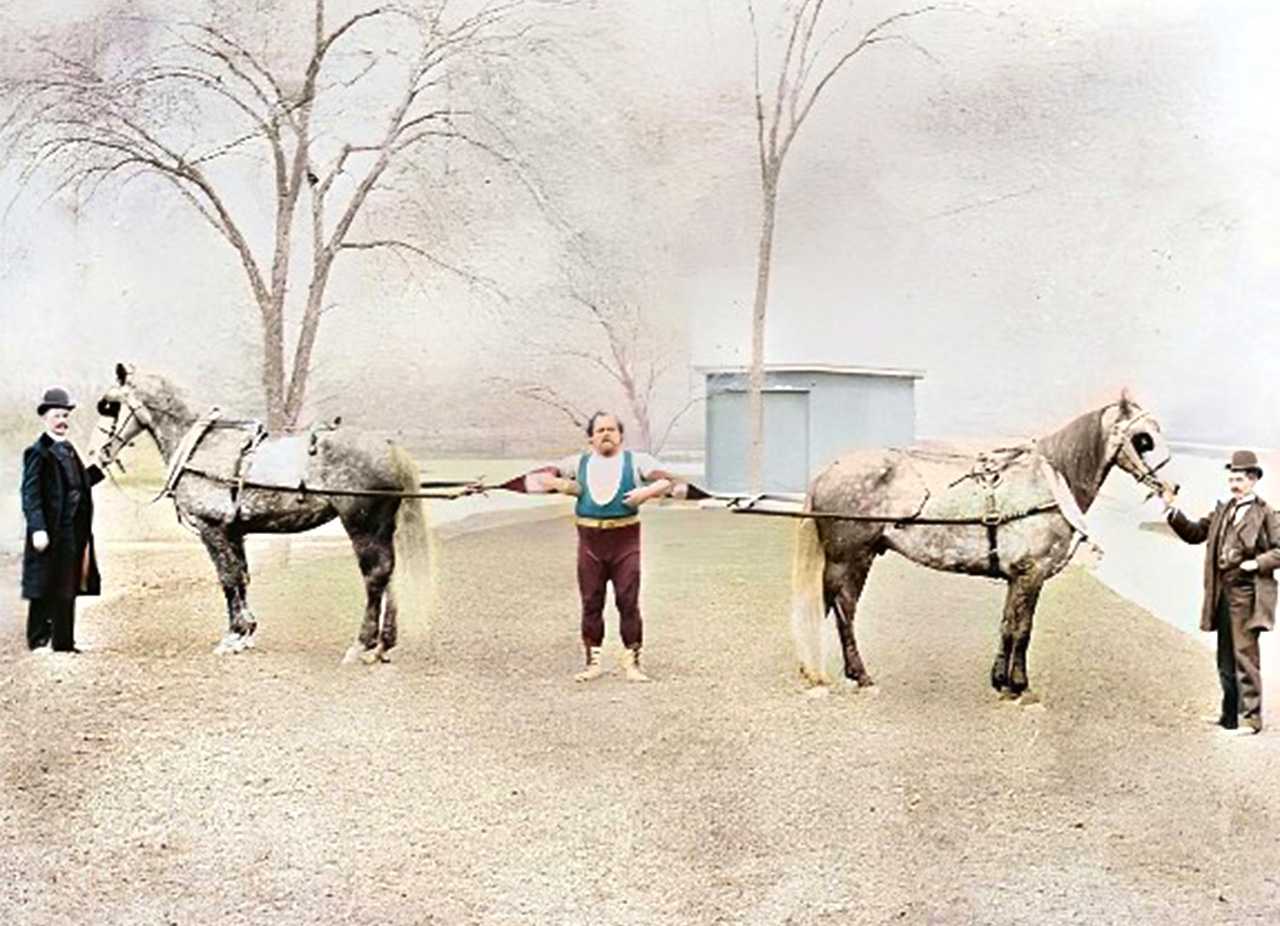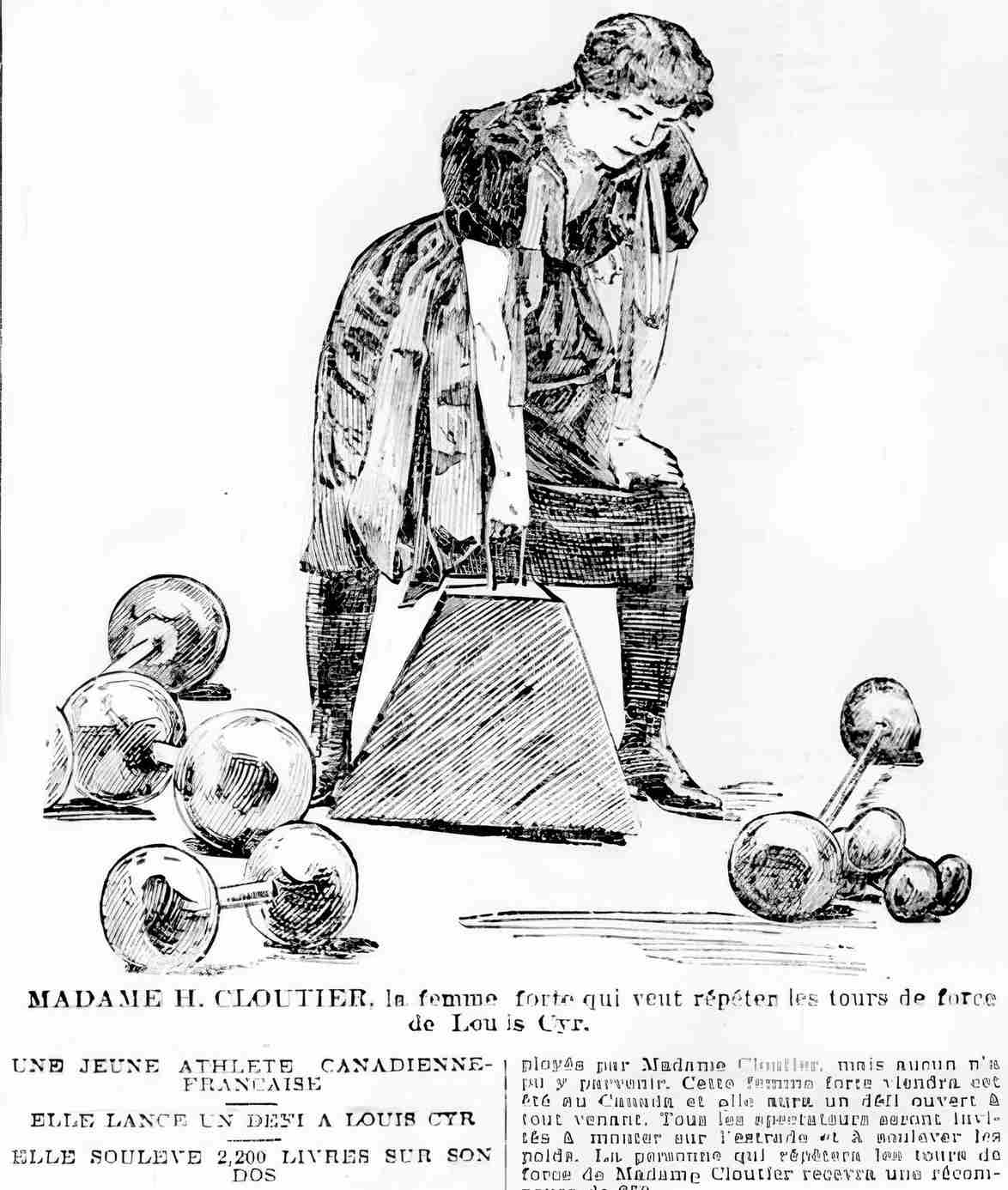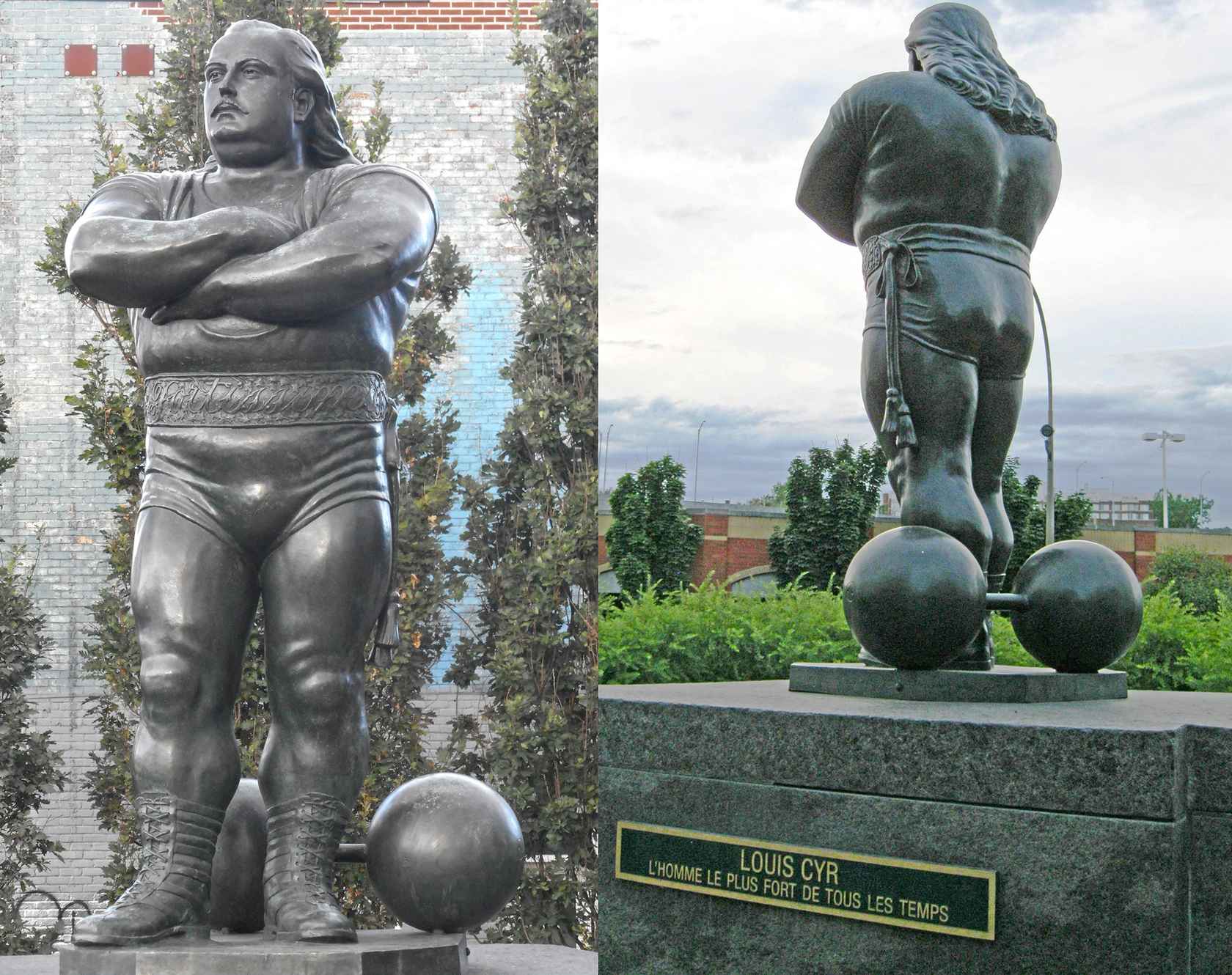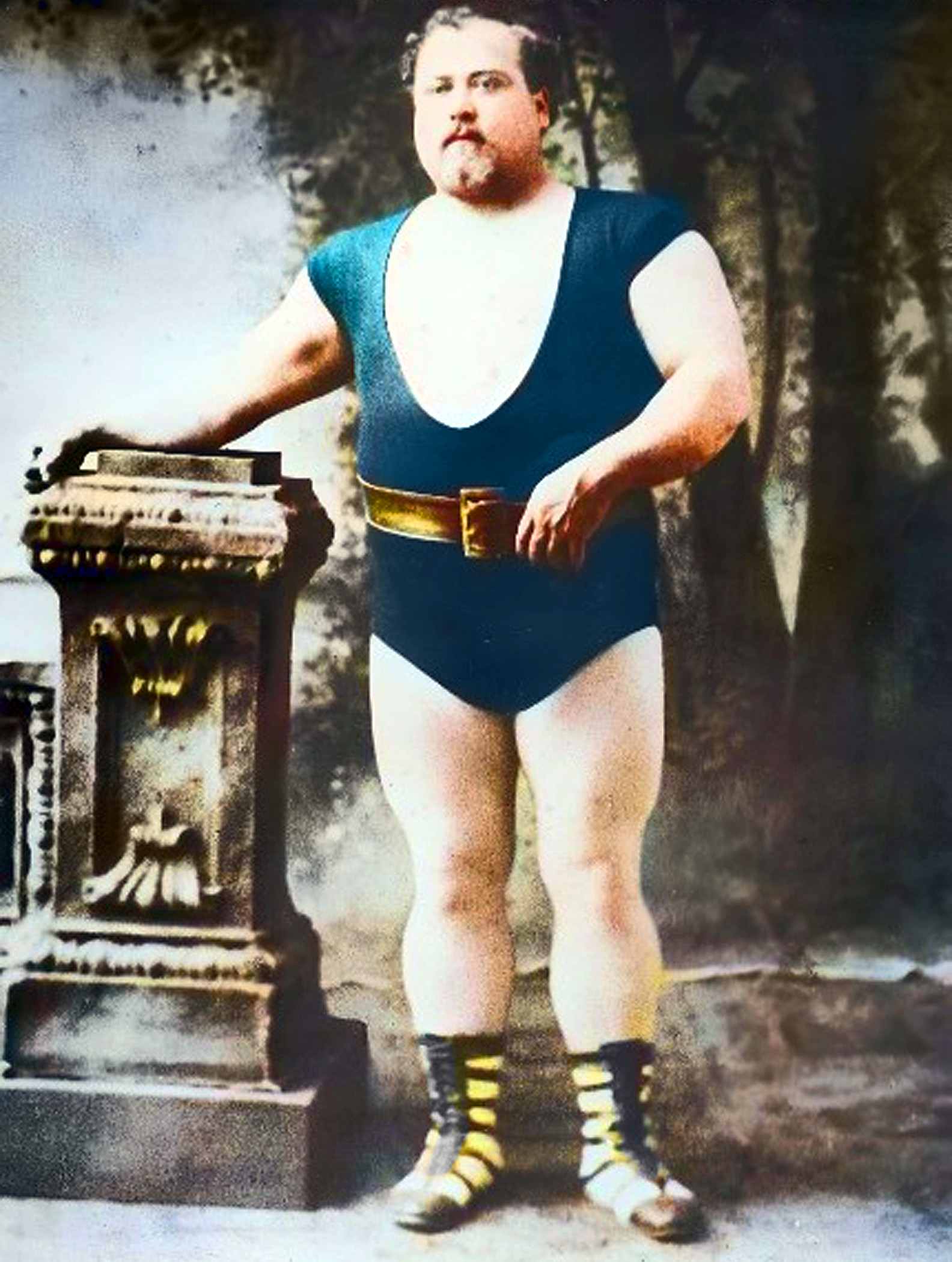Louis Cyr, originally named Cyprien-Noé Cyr, earned himself quite a reputation as a strong man and wrestler from Quebec during the late 1800s. He was born in 1863 in Saint-Cyprien-de-Napierville, Canada, and Cyr started showing off his unusual muscle power when he was just a child. Over time, people couldn’t stop talking about him because of the extraordinary weights he lifted.
Cyr amazed people by lifting platforms with many people on them, picking up over 550 pounds with just one finger, and even managing to restrain two horses at once. Louis Cyr was simply the strongest person on the whole planet. But later in life, he had some health problems. Still, even today, people remember him through cultural references, movies, and honors. He’s still known as one of the strongest men in history.

During his life, Louis Cyr never backed down from a fight and was unbeatable both at home and abroad. He became well-known even before weightlifting was included in the Olympics or any statistics were maintained on the sport.
Louis Cyr as a Child
Lower Canada (now Quebec) is where Louis Cyr (1863–1912) was born. He had 17 siblings (including 7 who died before adulthood). Cyr first showed his parents the sensation he would become when he was just eight years old. One summer, his dad had him go look for a runaway calf. Cyr discovered the animal in a ditch.
Since it was too weak to free itself, Cyr lifted it off the muddy trap and carried it home on his shoulders. He “crossed a full acre and a half in one go” and made an impressive debut for his parents, who were lost for words.

Cyr started working in a timber camp during the winter and on the family farm during the summer when he was just twelve years old. During this time, he often performed feats of strength that wowed his coworkers.
Around three years later, the Cyr family settled in Lowell, Massachusetts. Cyr, whose given name was Cyprien-Noé, chose to start using the name Louis instead since it was simpler to say for English-speaking folks there.
Louis Cyr First Time Seeing a Dumbbell
Louis Cyr’s incredible strength had made him famous once again in Lowell. His weight at age 16 was well over 200 pounds and he was 230 pounds at the age of 17. When he was just 18 years old, his incredible strength made him a sensation. He joined a strongman contest in Boston where the challenge was to lift a full-grown horse atop a platform. This platform had two sturdy metal bars for grasping, and the combined weight of the platform and horse amounted to 1650 pounds.
Lowell was the first place Cyr saw dumbbells, which belonged to Timothy Donovan. According to Louis Cyr, it was no problem at all to lift these 150-pound dumbbells. Donovan offered him a business proposition after seeing his strength.
Cyr agreed, but only if he was forbidden from using Donovan’s weights. In a foundry in Lowell, he had his first set of dumbbells manufactured, with the heaviest at 197 pounds, the second heaviest at 185 pounds, and the lightest at 156 pounds.
His future wife, Mélina Comtois, was from Saint-Jean-de-Matha, and he met her in Lowell. Two months after the Comtois family’s return to Canada, Louis followed suit. On January 16, 1882, the pair exchanged wedding vows at Napierville.
Cyr and his family moved back to Canada in 1882. He tied the knot with Mélina at Saint-Jean-de-Matha. Because he couldn’t find anything else, Cyr spent the winter months working at a logging camp.
He and his wife went back to Lowell in the spring of 1883 in an effort to cash in on his reputation there. He was accosted by one MacSohmer, who promised to show him across the Maritime Provinces and Quebec. Cyr was scammed out of any advantage from this trip while the organizer reaped all the rewards. After that, he and his relatives created a show they toured Canada with under the name “The Cyr Troop.” Cyr’s first child died during these years (1885–1886) and they canceled the show.
A more settled position as a police officer in the town of Sainte-Cunégonde on the island of Montreal (now a part of the Le Sud-Ouest or Southwest borough) was offered to Louis Cyr in the same year. He worked in this job until the end of 1885, after which he joined a traveling group of sportsmen led by Montrealer wrestler, boxer, and weightlifter Gustave Lambert. Émiliana, Louis Cyr’s daughter, who was also a weightlifter, was born in 1887.
A Duel Against the Champion
In Quebec, he competed in a strongman contest in March 1886 against David Michaud, the reigning Canadian strongman champion. The Jacques-Cartier Hall in Quebec City played host to the event, which included a $500 prize. When Cyr lifted a 218-pound dumbbell with one arm, Michaud could only manage 158 pounds, and when he lifted 2,371 pounds with his back, Michaud could only manage 2,071. At this point, Louis Cyr was known as the world’s strongest man.
In 1888, Louis Cyr established a bar on Montreal’s Notre-Dame Street and entertained customers with strength demonstrations. But the crowds were where he belonged, so after a little over a year, he started traveling again with his own group, this time including his wife and his brother Pierre. He went all around the United States and Canada.

In 1889, he prevailed and was recognized in London for lifting 559 pounds with one finger, 4,092 pounds with his back, and 273 pounds above his head with one hand.
He began performing with an American group in 1890 and quickly rose to prominence as the strongest man on the planet. He planned to defend his championship in Europe, so he headed back there in the autumn of the following year. The great champions, like the German bodybuilder Eugen Sandow, refused to confront him and instead handed the title to him after seeing him perform in England, where he was mostly popular.
Cyr and strongman Horace Barré signed a one-year contract with the American circus Ringling Brothers back in their own country in 1892. In 1894, the two men assembled a group of athletes, jugglers, acrobats, and strongmen to form their own circus. The circus toured North America for a total of five years.
In June 1895, Louis Cyr consented to undergo anthropometric measurements of his physique. His height measured 5 feet 9 inches, his weight was 324 pounds, his biceps circumference reached 21 inches, his neck size was 20.5 inches, and his chest circumference measured 61 inches.
The Strongest Against the Tallest
However, beginning in 1900, Cyr’s health began to decline because of his excessive weight, poor diet, and lack of physical activity. Due to his condition, Cyr had to give up competitive sports and public displays of power too soon. He eventually resided on a farm near Saint-Jean-de-Matha, where he entertained guests, told stories of his adventures, and sometimes faced off against challengers to his champion status, such as the 8-foot-3-inch Édouard Beaupré in 1901, one of the tallest humans in history.
In front of a crowd of around 3,500 people, Cyr fought and beat his last opponent, Hector Décarie, in Montreal’s Sohmer Park in December 1904, who was known to bent press 317 pounds at the time. Cyr recognized his own limits and frail health in February 1906, when he personally transferred his title to the young aspirant Décarie.
Louis Cyr Challenged by the World’s Strongest Woman

Louis Cyr, the world’s strongman champion, once thought unbeatable, faced an unexpected challenger in Henri Clouthier, a 28-year-old French-Canadian woman residing in the US. In 1898, she claimed she could match all of Cyr’s feats of strength and challenged him. Weighing 175 pounds and possessing a remarkable physique, Madame Cloutier declared herself the world’s strongest woman. She toured the US, inviting anyone to attempt her feats, but no one succeeded.
That summer, Madame Cloutier visited Canada for a challenge where spectators could try to replicate her feats, with a $50 reward for success. During a performance in Lowell on November 20, Louis Cyr declined her offer to restrain two horses he had famously stopped. Despite an official $100 challenge by Cloutier, an alleged “misunderstanding” prevented their showdown.
Madame Cloutier’s impressive feats included lifting 510 pounds with one hand, 913 pounds with both hands, and carrying a 2,000- to 2,200-pound platform on her back. She confidently stated her intention to replicate Louis Cyr’s iconic feat by restraining two horses, each weighing 1,400 pounds.
Louis Cyr’s Demise

At the Montreal home of his daughter and son-in-law, Dr. Zénon Maxime Aumont, Cyr died of chronic nephritis in 1912 at the age of 49. Four days later on the 14th of November, his body was laid to rest at Saint-Jean-de-Matha.
The next day’s newspapers carried the sad news of his passing. They ran front-page articles on his death and dedicated many paragraphs to detailing his life and career.
According to the reporter from Le Soleil, “his glorious career as an athlete […] contributed to casting an uncommon reputation for strength and physical vigor on the French-Canadian race.” His contemporaries erected a statue of their hero, which is currently housed at Quebec’s Museum of Civilization, to honor Louis Cyr and his legendary achievements.
The Monument to Louis Cyr is a sculpture by Robert Pelletier (1914-1984) located in the Saint-Henri district of Montreal. It was inaugurated in June 1973 in Elizabeth Square, renamed Parc des Hommes-Forts in 1994.
Louis Cyr’s Achievements

Louis Cyr’s strength may have been overstated on occasion, but the verified ones are still remarkable even today:
- Moving a platform with 18 people on it (4,281 pounds) on his back.
- Using just one finger, he lifted 484 pounds (at the New York headquarters of the National Police Gazette).
- He pushed a wagon on an inclined plane.
- He used his right hand to raise 273 pounds over his head.
- At the age of 19, he set a still-valid world record by raising a stone weighing 514 pounds off the ground and onto his shoulders.
On May 27, 1895, Louis Cyr reportedly carried 4,336 pounds on his back, which was his highest achievement. On October 12, 1891, in Montreal, he performed another famous experiment, this time with four horses tied together such that each pair pulled in different directions. In 1892, upon his return to London, he performed the same feat, this time using two carriage horses provided by the Marquess of Queensberry.
According to some people, Cyr’s records still remain undisputed, but according to others, Victor Delamarre, another French-Canadian, smashed his four world records with a single dumbbell push of 309 pounds on April 2, 1914, which was two times his own body weight.
The 2013 movie Louis Cyr talks about his world records as such:
- Iron Cross: 97 pounds left hand and 88 pounds right hand.
- One-Hand Snatch: 188 pounds.
- One-Handed Press: 273 pounds.
- Back Lift: 3635 pounds.
- Two-handed lift: 1897 pounds.
Louis Cyr’s Honors
- The Montreal area of Saint-Henri, which he policed, is now known as Louis-Cyr in his honor. In honor of him, two parks—Louis-Cyr Park and the Strong Men’s Park—have been created.
- Napierville is the site of a high school named in honor of him, École Louis-Cyr.
- Saint-Cyprien-de-Napierville, France, officially recognized him as a historical person on April 18, 2013.
Louis Cyr in Modern Culture
- Antoine Bertrand portrayed the strongman in Daniel Roby’s 2013 film, Louis Cyr.
- His tale is also told in “The Strongest Man in the World: Louis Cyr,” an illustrated book written and released in 2007 by Nicolas Debon.
Worth Noting
- There is a famous saying in Canada called the Law of Square Chaboillez, where Louis Cyr lies at the center of the story:
- The law of Square Chaboillez originates from an amusing incident involving Louis Cyr, who was a police officer in Montreal around 1885. On a scorching day, while patrolling with another policeman, he received news of Mr. Tremblay’s deceased horse lying on the square. When Cyr’s coworker tried to report the incident, he was unable to spell “Chaboillez” because the street sign was not visible. He turns back to Louis Cyr: How do we write Chaboillez? After some quick thinking, Cyr bent over, picked up the horse, and crossed to the corner of the other street. The horse is dead on Notre-Dame Street. Rather than doing or saying something stupid, they got around the problem in a clever way, creating the Chaboillez Square law.
- Louis Cyr’s family roots are in Acadia, a colony of New France in northeastern North America. Jean Sire, his ancestor, moved to Grand-Pré, Acadia from the Flanders area of France. During the chaos of the Expulsion of the Acadians (“Great Upheaval”), Jean’s grandson Paul Sire settled in Acadia, in Haut-Richelieu. In North America, Louis Cyr represented the eighth generation of his family.
References
- The Strongest Man in History – Google Books
- Louis Cyr (2013) – IMDb
- The Strongest Man in the World – Google Books


